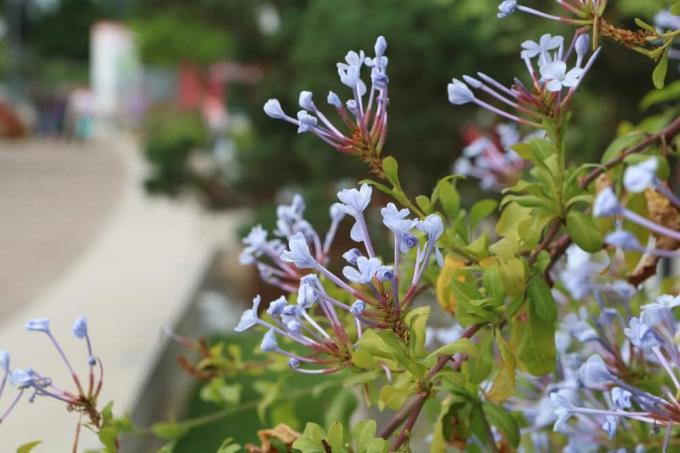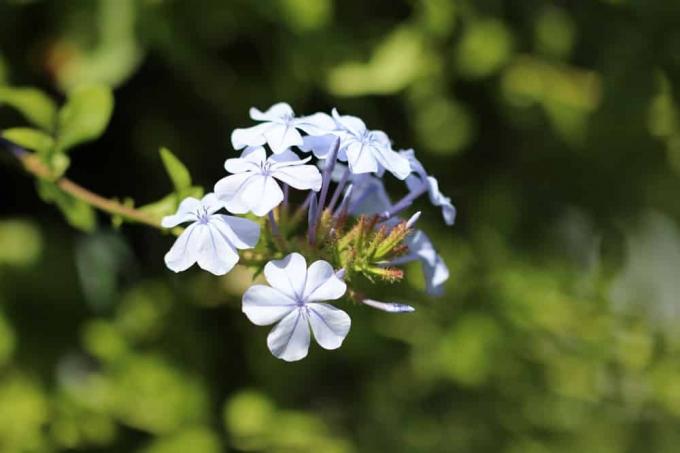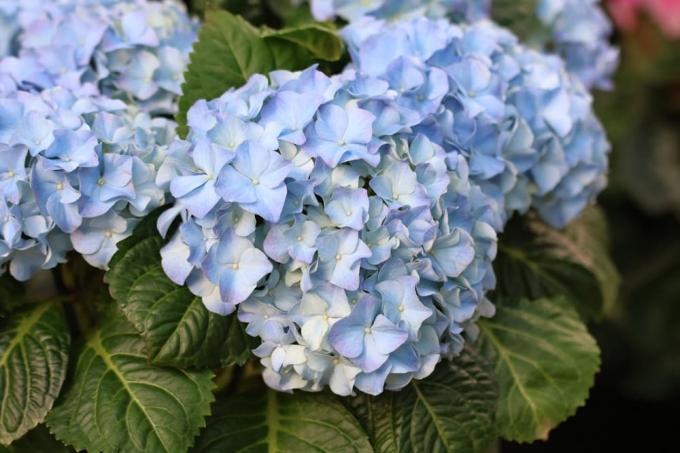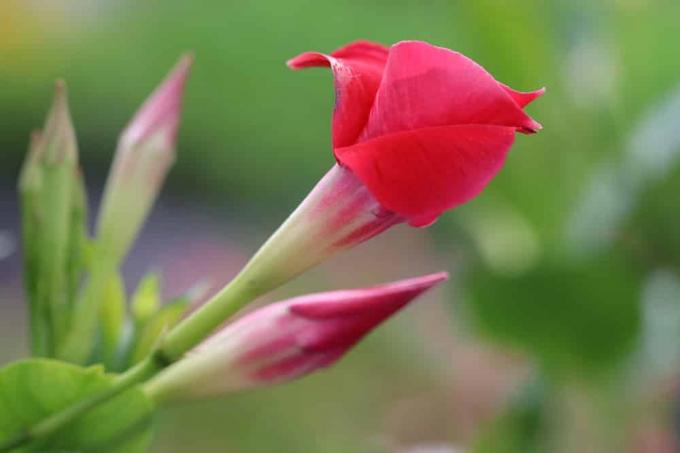

Table of contents
- Characteristics
- use
- Location
- substrate
- planting partner
- Plant
- repot
- Pour
- Fertilize
- Cut
- Poisonous
- hibernate
- propagation
- Diseases
- pests
Plumbago originally comes from South Africa, where it grows up to four meters tall. Contrary to its rather sad-sounding name, the plant is a showy ornamental shrub with overhanging or slightly climbing branches. Leadwort never tires of presenting its sky-blue or white, phlox-like blossoms in sunny locations all summer long.
Characteristics
- botanical name: Plumbago auriculata (synonym: Plumbago caspensis)
- other names: Leadwort, Plumbago, Cape Leadwort
- Plant family: Leadwort family (Plumbaginaceae)
- Growth form: dense, upright shrub, slightly overhanging
- Growth height: 1.5 to 2 m
- leaves: lanceolate with a smooth margin
- Flowers: Umbrella-like racemes with sky blue or white flowers
- Flowering period: May/June to September
- perennial
- not hardy
use
Unfortunately, the Cape leadwort is not hardy in our latitudes. For this reason, it is used almost exclusively as a container plant for balconies and terraces. The shrub grows vigorously and quickly, with the branches spreading widely and beginning to climb. These properties create ideal conditions for a wide range of possible applications. The long, flexible shoots can easily be guided along a climbing frame or overhanging a balcony railing. With a little patience, high stems can also be cultivated. Because of the enormous growth potential, however, this involves a great deal of work.
- perennial in bucket culture with frost-free overwintering
- annual culture in beds and borders
Location

As the South African origin already suggests, the leadwort likes to be as warm and sunny as possible. The shrub is therefore widespread as an ornamental plant in the tropical and subtropical regions of the world. Because of the lack of frost hardiness, Plumbago auriculata is cultivated in cooler areas as a container plant. In general, the rule applies: the darker the location, the fewer flowers are to be expected.
- Light requirements: full sun to light semi-shade
- Root ball preferably in the shade
- sheltered from the wind
- protected from rain (flowers rot when wet)
substrate
The Plumbago makes no special demands on the soil. It should be rich in nutrients, permeable and evenly moist. However, you should note that potted plants only have a very limited space for the roots. When cultivating in planters, only use high-quality potting soil that can drain water well. At the same time, the substrate should be able to store moisture and nutrients well and remain permeable to air. It is also easy to make a suitable substrate yourself from:
- garden soil or potting soil
- Compost or humus (high percentage)
- coarse-grained parts: lava granules, expanded clay or coarse sand
planting partner
Cape leadwort's lavish blue blooms combine effectively with a pink bougainvillea or oleander. On trellises, the morning glory (Ipomoea purpurea) is one of the suitable companion plants that provide a nice contrast. In balcony boxes, leadwort overhangs elegantly between geraniums (pelargonium). And its simple light blue flowers also look good next to roses.
Plant
The planter for lead root should be generous, because the shrub can only develop optimally with sufficient space for the roots. Large plant boxes and flower pots also have the advantage that a trellis can be integrated to provide support. Watch out for drainage holes in the ground, as waterlogging has a negative effect on the health of the plant. An underplanting provides shade in the root area and thus reduces the effort for care.
- Material: plastic, clay or stone
- Cover vent holes with potsherds
- Drainage layer: at least 5 cm expanded clay or hydroponic granules
- Planting depth: as before
- Fill in the soil and press down lightly
- water vigorously
By the way:
Did you know that the root area of potted plants overheats less often in wooden or terracotta pots than in plastic pots?
repot
When a plant should be repotted depends on various factors. In general, younger leadworts have very strong root growth and therefore often need a larger pot than older, well-established shrubs. If the roots are already growing through the drainage hole, the plant should be repotted after the winter. In most cases it is sufficient to pull the root ball out of the pot in spring and take a closer look. If there is already a dense, light-colored root network on the outside and underside, it is time for a larger pot.
- Time: spring
- after the end of the rest period (March to early May)
- young plants: annually
- older plants: every three years at the latest
- remove as much old substrate as possible
- possibly use a larger pot
- Fill in fresh substrate and press firmly
Tip:
If a plant is over-fertilized or suffers from rotten roots due to waterlogging, it must be planted with new soil immediately. The time of year doesn't matter.
Pour

Almost all potted plants need a lot of water in summer. Cape Leadwort is no exception. Preferably use rainwater or stagnant tap water for watering. The root ball should always be slightly damp, but never waterlogged. On hot days, watering in the early morning hours is recommended. Leave some irrigation water in the saucer, which will serve as a supply throughout the day. If the leaves are already hanging limp by midday, do not wait until the evening before watering again. Plants need a lot of water under the following conditions:
- in the main growing season (May to September)
- in windy or full sun locations
- in great heat
- in a wooden or clay pot
- in relatively small planters
- for substrates with a high proportion of clay or sand
In winter, the soil moisture is maintained evenly, but without producing waterlogging. As the leaf mass decreases, of course, the water requirement also decreases. Therefore, only water in small sips in a cool area.
Fertilize
Whether in a bed, in a tub or in a planter: watering and fertilizing are part of the regular care of the ornamental shrub throughout the entire growth period. Between April and August, the plant is fertilized weekly with a universal container plant or liquid concentrate over the irrigation water. Alternatively, it is possible to use long-term fertilizers. This must be refreshed in June. From mid-August, stop fertilizing completely, because the soft plant tissue still has to lignify slightly before overwintering.
Cut
In order to keep their unbridled growth in check and to guarantee a lasting abundance of flowers, secateurs are the most important utensil when caring for the South African beauty. As tempting as it may be to leave the bush to its own devices, within just a few years it tends to become rampant, out of shape and flowering very sparingly. Luckily, a Plumbago is very pruning-tolerant, making it easy to keep the overgrowth under control. In addition, regular pruning is perfect to encourage the formation of new flowers. Leadwort only blossoms on one-year-old wood. The more new shoots sprout, the more lush the blue blossoms will be. Preferably cut in the following steps:
fall pruning
- Time: before being put into winter quarters
- Cut back faded shoots
- cut it in half in total
spring pruning
- Time: February to March
- Heavy pruning down to 25 cm per shoot
- remove any dead or diseased shoots
- Prune inward growing branches
Care and maintenance cut
Shoots that are too long or sparse can be cut back at any time during the growing season. Also use this opportunity to check whether any branches are diseased or dead. Since the withered flowers do not fall off, you should also cut them out occasionally over the summer.
Tip:
To stimulate branching, it has proven useful to cut off the tips of the new shoots again after about a month.
Poisonous
Leadwort is considered slightly poisonous. The consumption of plant parts should therefore be avoided. However, little is known about the ingredients and mode of action of the toxic components. No health hazards are to be expected in daily care.
hibernate

Unfortunately, the otherwise robust container plant is not hardy, so it needs suitable quarters for the cold season. Although the heat-loving flowering shrub tolerates a light touch of frost, the plant usually does not survive overwintering outdoors. In order not to take any risks, place the leadwort in a cool room before the first night frosts, at the latest when the temperature is below -5 degrees. Depending on the heat and light available, the plant sheds most of its leaves. Defoliated plants can also stand in the dark, which makes overwintering and care much easier.
- hardy to -5 degrees
- Staircase, cellar, garage, cool conservatory
- Temperature: 5 to 10 degrees
- water only moderately
- Do not let the root ball dry out completely
- Check regularly for pest infestation
The new growing season for Cape leadwort begins in April. Place the plant a little warmer again and increase the watering amounts with the new shoots. If no more frosts are to be expected from mid-May, the plant can go outdoors again.
Tip:
When putting them into winter quarters, the plants should not be too wet, otherwise there is a risk of rot.
propagation
Plumbago can be propagated both from seed and from cuttings. Propagation by cuttings promises greater success.
- When: May to June
- Use half-ripe shoots (only very slightly woody)
- Shoot tips without flowers
- Length: 15cm
- tear off carefully
- remove lower leaves
- 2 to 4 upper leaves preserved
- Substrate: loose, nutrient-poor soil (cactus soil, seed soil)
Insert the shoot about five centimeters deep into the moistened substrate and lightly press the soil. Cover with a plastic bag or a clear plastic pot to prevent excessive evaporation. In a bright location without direct sunlight, the cutting needs about four weeks to form the first roots. Successful rooting can be recognized by new buds and leaves forming. Once the cutting has reached a height of 30 cm, the tip is cut off for better branching.
Diseases
Cape leadwort are considered to be less susceptible to diseases. However, gray mold can occasionally occur. Gray mold mainly develops on wet flowers and leaves in the warm season. You can avoid it by regularly removing faded plant parts and a rain-protected location.
pests
Check the plant regularly for sucking insects such as aphids or spider mites, especially during the winter. A mild infestation can be treated with home remedies. A mixture of water, alcohol and a few drops of washing-up liquid, with which you spray the undersides of the leaves in particular, has proven effective. After two weeks, this procedure must be repeated again to kill the offspring of the pests.
 garden editorial
garden editorial I write about everything that interests me in my garden.
Learn more about potted plants

Spider Flower, Cleome hassleriana: Care Instructions
Spider flowers get their name from their spider-like appearance. Many hobby gardeners shy away from cultivating the beautiful exotic species. When it comes to maintenance, there are just a few things to keep in mind.

How do I care for a gentian tree? Lycianthes rantonnetii
A gentian tree can be a decorative enrichment both on the balcony and in the garden. For the culture, however, some criteria must be observed. This includes, among other things, the high nutrient content that is required for flowering.

Overwinter pampas grass | 16 tips for winterizing
Pampas grass is a popular ornamental plant in the garden or in tubs, which can be attractively integrated into a wide variety of garden ideas thanks to its decorative fronds. They are considered hardy, but need suitable winter protection in Central Europe due to possible moisture damage.

Hydrangeas, rhododendrons and hibiscus smoke | dangers of drugs
Anyone who has cultivated hydrangeas, rhododendrons or hibiscus in the front yard may be surprised that the beautiful flowers were cut off by strangers. Because especially among young people, there is a rumor that these flowers can be smoked and have the effect of marijuana. But this is dangerous information.

Peasant hydrangea, Hydrangea macrophylla - care and pruning
With its attractive, ball-shaped umbels of flowers in white, pink, purple, red or blue, the hydrangea is one of the most decorative garden plants. Here's what you need to know about the farmer's hydrangea so that it blooms and thrives lushly in your garden.

Dipladenia 'Sundaville red' - Caring for the Mandevilla as a houseplant
With its bright red, trumpet-shaped flowers, Dipladenia 'Sundaville red' - which is a hybrid of the tropical Mandeville or Mandevilla is a beautiful eye-catcher on the balcony or terrace. However, the climbing plant can also be easily maintained in the living room.



